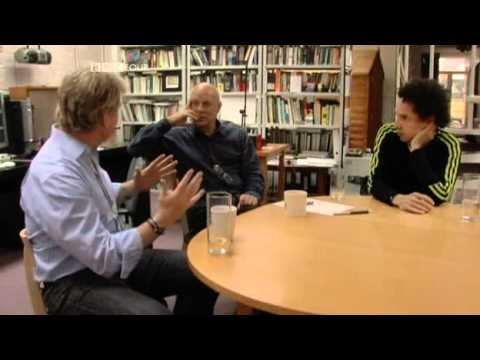Fascinating documentary on Brian Eno by BBC’s Arena (he provided the music for their famous floating bottle logo) about how he works and his life. I especially love the whole thing about coming from family of postmen ‘we’re in communications!’ and him going fossil hunting as a kid.
But the thing it seems people remember from this documentary is his take on digital works – that you smooth all the edges out til it’s not human anymore. I think partly that is a generational thing, but it’s true, digital creation can be a rabbit hole that you never leave and it’s tempting to polish all the humanity out. Hence as he points out, there are plugins now to add hiss, crackle, noise and even in the video world I’ve come across plugins to make something look like old VHS or Beta. (The problem is that computers don’t do random well, so never actually does sound or look like the real thing – it’s like cross process filters, they don’t actually look like proper film cross processing since the interplay of developing chemicals is much more random than a machine can simulate).
Although it is worth knowing your tools – I saw a few digitally created works at the Affordable Art Fair and I was like, ‘bless’ and ‘it will be good when you actually learn Photoshop!’. It seems not much has changed from when I was at art school and my fellow artists did not touch a computer until the final year with their dissertation. I didn’t get a feeling that the computer was at the core of their work, more they were trying to do traditional techniques on an untraditional medium – rather strange for people who grew up in the age of the internet.
Or like the early Gilbert & George digital works which weren’t that good – but I notice the recent ones have gotten far more adept in using and abusing the technology. But mistakes ARE important, especially in music and art, the groove and indeed humanity is not on a click track. But as they used to remind us at art school – you have to know the rules to break them – I do feel a lot of people run before they can walk in the digital space, or don’t treat it as a new tool in of itself – but it can also impose a sort of regularity and conformity you need to a bit clever to get away from. It’s not that hard, you can bring noise into the signal path in many ways – just be human.
As indeed another ‘rule’ – Eno’s first written Oblique Strategy that says ‘honour thy error as a hidden intention’ (see the video at the bottom of this post for an explanation of that).
When I was at the Negativland True False gig recently – I need to post those videos – I noticed the excellent visuals from Sue C. were basically from a slide projector or overhead projector with transparencies, plants, real world objects as a source, then digitally processed. People love old VHS and indeed have quite often gone back to vinyl. Cassette of all things has made a comeback and people are releasing new albums on minidisc over at Bandcamp. Old technology is nostalgic but also has hiss, crackle, analogue warmth – errors in the signal basically but it seems our brains get bored of things that are too smooth, too perfect, too clean?
Or maybe this is just Gen-X getting nostalgic and becoming the dominant generation now they have some money? I dunno. Certainly ‘Fifty Quid Man’ is now ‘A Hundred Quid Man’ as vinyl is so eye-watering in price. £30-40 for vinyl? Oh do fuck off.
Anyway I notice there is another more recent BBC documentary (I hesitate to call it that) with Brian talking about his light works, generative pieces and his music production. Not much has changed in his studio but he is a fascinating man – which rises above the really poor production quality.
(Incoming technical rant! I mean the BBC cannot afford better than DSLRs without stabilisation or competent camera people to run them? I hear a lot of despair from fellow editors, and this is a good example why….they didn’t even grade the cameras equally! Odd editing of pickup/reaction shots and shaky distracting movement I would cut – there are three cameras, at least ONE of them must have an shot in focus and not moving at that point? I am doubtful though given the skill of the operators. Sound is thankfully good though.
And yet these people would not hire me even though I could do a far better job on an old Canon XL, my little Olympus or a smartphone or even with free editing software like Resolve? Usually I don’t judge YouTube in the same way as broadcast TV, but this is so bad it almost gets in the way of the interview, which is very good.
Ironically that shows that ‘too much noise’ in the system can be bad, being too shaky and out of focus and too human can distract. It’s a balance really between distorted noise and ultra-shiny pop…you want to humanise things, but if that means the work is hard to watch or hear then it can be too chaotic. Or it needs to be intentional, a part of the work…I used to run down the street with Hi-8 in Sheffield and film the lights at night, and then slowed it down on shuttle in the editing studio at University, getting brilliant flashes of colour – probably errors in the system. This isn’t intentional.
And it’s why I gave up on the broadcast/media industry and decided to concentrate on my own art but it is galling when those who DO have jobs in the industry can’t do them better than my own home DIY attempts with far less kit. Does feel that it’s more who you know and who your daddy is than talent. Grr…)
Thanks to Peter Daniels for sharing the first documentary.


Leave a Comment! Be nice….